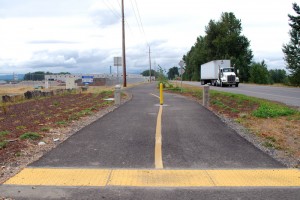Port to add bike paths on Lower River Road
 VANCOUVER, Wash. –The Port of Vancouver USA was awarded two grants from the Federal Transportation Alternatives Program (TAP), which funds projects that support safe and efficient alternative transportation, such as bike and pedestrian paths. These grants, awarded in July of this year, total just over $350,000, and will allow the port to accelerate plans to provide safe bike and pedestrian access along port property on Northwest Lower River Road.
VANCOUVER, Wash. –The Port of Vancouver USA was awarded two grants from the Federal Transportation Alternatives Program (TAP), which funds projects that support safe and efficient alternative transportation, such as bike and pedestrian paths. These grants, awarded in July of this year, total just over $350,000, and will allow the port to accelerate plans to provide safe bike and pedestrian access along port property on Northwest Lower River Road.
Specifically, $289,600 in grant funding will be used to design and build a bike and pedestrian path that begins at the convergence of Mill Plain, Fourth Plain and Lower River Road and continues west along Lower River Road for approximately one half mile to the entrance to the port’s administrative building. The 12–foot pathway will separate pedestrians and cyclists from higher speed traffic and offer safe access to jobs and recreational areas along Lower River Road. Construction is expected to begin in February 2014.
The remainder of the grant funding will be used to design a 1,750-foot section of pathway that will complete the connection to an existing 2,700-foot multi-use path, located between the port’s administrative building and Gateway Avenue, located to the west on Lower River Road. Construction of the existing path was completed by the port in March of this year as mitigation for the new Farwest Steel facility.
The grant funded projects are part of the port’s overall plan to construct approximately 3.7 miles of safe passage for bicyclists and pedestrians along Lower River Road. When complete, the port project will connect downtown Vancouver to the Flushing Channel at Vancouver Lake. Future segments of the path will be funded as the port’s western properties such as Columbia Gateway are developed, or as additional grant funds are acquired.
The port’s ongoing efforts to construct the multi-modal pathway are grounded in its mission “to provide economic benefit to our community through leadership, stewardship and partnership in marine and industrial development.” A result of strong relationships with local governments and community groups, the port’s pathway project will connect residential areas, the city of Vancouver’s bike path system, and C-Trans’ bus service network to the maritime and industrial businesses along Lower River Road, which make up one of Clark County’s largest job centers.
Currently, approximately 2,300 people are employed by businesses at the Port of Vancouver USA, with 80 percent of those workers living within Clark County. Additional local employers residing on Lower River Road include Clark Public Utilities, Clark County Work Center, Tidewater Barge, Hickey Marine Enterprises, Fazio Brothers Sand Co., Inc., and West Van Material Recovery. Based on port projects alone, close to 2,000 jobs are projected to be created over the next five to 10 years.
When complete, the pathway will provide additional benefit to the community in that it will also link neighborhoods to some of our region’s most utilized recreational areas such as Frenchman’s Bar Park on the Columbia River, Vancouver Lake Park, and a multitude of bird and wildlife viewing areas located within the Vancouver Lake Lowlands.
Support letters from Bike Clark County, the Clark Communities Bicycle and Pedestrian Advisory Committee, the Vancouver-Clark Parks and Recreation Department, and the Fruit Valley, Arnada and Shumway Neighborhood Associations were included in the port’s application for the TAP grant funding.
– POV –
The Port of Vancouver USA is one of the major ports on the Pacific Coast, and its competitive strengths include available land, versatile cargo handling capabilities, vast transportation networks, a skilled labor force and an exceptional level of service to its customers and community. For more information, please visit us at www.portvanusa.com.
